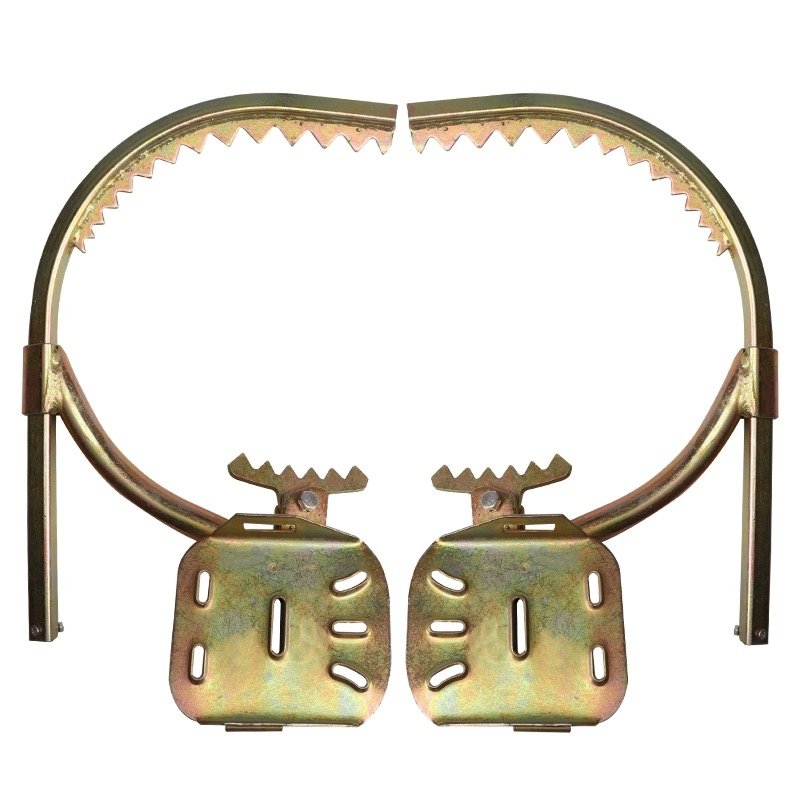
Mastering Wooden Pole Climbers: A Comprehensive Guide
The ability to climb wooden poles is an essential skill in various professions, particularly in telecommunications and utility sectors. Wooden pole climbers—specialized gear worn on the legs to provide grip and support—are integral to this task. Mastery of these tools not only enhances productivity but also ensures the safety of the climber.
Wooden pole climbers are versatile tools designed to enable easy and safe ascension of wooden poles. By following appropriate techniques and safety measures, climbers can effectively use these tools to perform tasks high above the ground.
Understanding Wooden Pole Climbers
Wooden pole climbers, also known as climbing spikes or gaffs, are composed of several key components: the gaff (spike), stirrup (foot support), straps, and padding. The sharp gaffs penetrate the wood, providing the needed grip, while the straps and padding offer stability and comfort.
Choosing the Right Equipment
Selecting the right type of wooden pole climbers is paramount. Factors to consider include the height and strength of the pole, the weight of the climber, and the specific requirements of the task. Climbing spikes come in different lengths and designs; shorter spikes are suitable for softer woods, while longer spikes work better on harder woods. Adjustable straps and padded stirrups enhance comfort during prolonged use.
Pre-Climbing Safety Measures
Prior to climbing, it is crucial to conduct thorough gear inspections and ensure all components are in good condition. Check the spikes for sharpness and integrity, inspect the straps for wear and tear, and verify that the padding is sufficient and intact. Wear appropriate protective gear, such as a hard hat, gloves, and safety glasses, to safeguard against potential hazards.
One of the key pre-climbing preparations is to thoroughly inspect and plan the climbing route. Pay attention to any damages or irregularities on the pole and ensure the surrounding area is clear of obstacles. Practicing the climb on a lower pole or training structure can be beneficial for honing skills and boosting confidence before tackling higher poles.
Mastering Climbing Techniques
Effective climbing techniques are essential for both safety and efficiency. Begin by positioning your spikes correctly: the gaffs should dig into the pole at a comfortable angle, allowing for stable support. Maintain an upright posture, keeping your arms straight and using your legs to push upwards. This reduces strain on the upper body and helps conserve energy.
Ascend the pole step-by-step, ensuring each spike is firmly lodged into the wood before making the next move. Use your arms for balance but rely on your legs for upward movement. As you climb, periodically adjust the straps to maintain a secure and comfortable fit.
Descending a pole requires a different technique. Lean back slightly, keeping your weight centered over the spikes, and carefully move downward in small, controlled steps. Use your legs to lock into the wood gently with each step, ensuring a safe descent.
Troubleshooting Common Issues
Despite careful preparation, issues may sometimes arise during a climb. Slipping spikes, discomfort, and fatigue are common challenges faced by climbers. To address these, regularly inspect and adjust the equipment as needed. Ensure spikes are always sharp and properly positioned, and periodically take breaks to alleviate muscle fatigue.
If a slip occurs, remain calm and regain your footing by repositioning the spikes. Discomfort can often be alleviated by adjusting the straps and padding for a better fit. Building strength and endurance through regular practice and physical conditioning can also mitigate these issues.
Enhancing Safety Protocols
Adhering to stringent safety protocols is vital in preventing accidents. Always conduct a thorough inspection of equipment before use, and replace any worn or damaged components. Follow industry guidelines and best practices for climbing techniques and use personal protective equipment consistently.
Buddy systems can enhance safety. Having a fellow climber or ground support person to assist and monitor during a climb can provide an extra layer of security. In case of emergencies, immediate assistance is crucial, reinforcing the importance of having a reliable system in place.
Conclusion
Effectively using wooden pole climbers involves a combination of selecting the right equipment, adhering to safety measures, mastering climbing techniques, and troubleshooting common issues. By following these guidelines, climbers can efficiently and safely perform their tasks, ensuring both productivity and personal well-being.
Mastery of wooden pole climbers is an ongoing process. Regular practice, continuous learning, and strict adherence to safety protocols are key. Whether you are a seasoned professional or a newcomer to pole climbing, these principles will help you navigate the challenges and excel in your endeavors.
FAQ
Q1: What type of wood is easiest to climb with wooden pole climbers?
A1: Softer woods are generally easier to climb as the spikes can penetrate more easily.
Q2: How often should I sharpen my climbing spikes?
A2: Climbing spikes should be sharpened regularly, ideally before each use, to ensure optimal performance and safety.
Q3: Can wooden pole climbers be used on other materials besides wood?
A3: Wooden pole climbers are specifically designed for wood and may not perform effectively or safely on other materials.
Q4: What should I do if my straps start to wear out during a climb?
A4: If you notice wear on your straps during a climb, it's best to descend safely and replace the straps before attempting another climb.
Q5: Is it necessary to have formal training to use wooden pole climbers?
A5: While not always mandatory, formal training is highly recommended to ensure proper technique and safety when using wooden pole climbers.

















